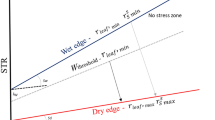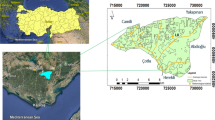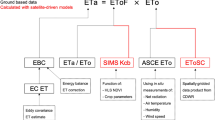Abstract
Assessment of water consumption is a crucial task for irrigation management in grapevines, especially in areas with limited water resources, which is the case of California Central Valley. This study evaluated the utility of the Simple Algorithm for Evapotranspiration Retrievement (SAFER) model to estimate daily and seasonal actual evapotranspiration (ETa) using Sentinel 2 images at 10-m spatial resolution and 5-day revisit time in 3 vineyards located at two sites in California. A unique characteristic of this model is the estimation of “synthetic” temperature maps, which are used as part of the estimation of ET and energy balance. The SAFER energy balance results were validated with six eddy covariance (EC) flux towers as part of the Grape Remote-sensing Atmospheric Profile and Evapotranspiration eXperiment (GRAPEX). The estimated surface temperature derived from upwelling longwave radiation measurements was closely correlated with the observed sensor surface temperature with R2 higher than 0.86 for the analyzed EC towers. After performing an internal calibration, SAFER root mean square error (RMSE) values on daily ETa were between 0.64 and 0.75 mm day−1. Additionally, the seasonal ETa was estimated and compared with the EC observations showing an average R2 ranging from 0.64 to 0.52 mm/season. Spatial patterns of ETa showed variability between sites and producer management activities. The results found indicate both limitations and potential utility of SAFER for irrigation management in vineyards using daily or seasonal ETa under different irrigation treatments.













Similar content being viewed by others
Notes
Mention of trade names or commercial products in this publication is solely for the purpose of providing specific information and does not imply recommendation or endorsement by the U.S. Department of Agriculture.
References
Aboutalebi M, Torres-Rua AF, McKee M, Kustas WP, Nieto H, Alsina MM, White A, Prueger JH, McKee L, Alfieri J, Hipps L (2020) Incorporation of unmanned aerial vehicle (UAV) point cloud products into remote sensing evapotranspiration models. Remote Sens 12(1):50
Alfieri JG, Kustas WP, Prueger JH, McKee LG, Hipps LE, Gao F (2019) A multi-year intercomparison of micrometeorological observations at adjacent vineyards in California’s Central Valley during GRAPEX. Irrig Sci 37:345–357
Allen RG (2000) REF-ET, reference evapotranspiration calculator version windows 2.0. Univ of Idaho Res. And Ext Center, Kimberly, p 82
Allen RG, Pereira LS, Raes D, Smith M (1998) Crop evapotranspiration. Guidelines for computing crop water requirements. FAO Irrigation and Drainage Paper. FAO, Rome, p 56
Allen RG, Hartogensis O, de Bruin HAR (2000) Long-wave radiation over alfafa during the RAPID field campaign in Southern Idaho; research report. Univ of Idaho, Kimberly
Allen RG, Tasumi M, Trezza R (2007) Satellite-based energy balance for mapping evapotranspiration with internalized calibration (METRIC)—model. J Irrig Drain E 133:380–394
Anderson MC, Kustas WP, Norman JM, Hain CR, Mecikalski JR, Schultz L, González-Dugo MP, Cammalleri C, d’Urso G, Pimstein A, Gao F (2011) Mapping daily evapotranspiration at field to continental scales using geostationary and polar orbiting satellite imagery. Hydrol Earth Syst Sci 15:223–239
Bastiaanssen WGM, Menenti M, Feddes RA, Holtslag AAM (1998) A remote sensing surface energy balance algorithm for land (SEBAL): 1. Formulation. J Hydrol 212–213:198–212
Cai JB, Liu Y, Xu D, Paredes P, Pereira LS (2009) Simulation of the soil water balance of wheat using daily weather forecast messages to estimate the reference evapotranspiration. Hydrol Earth Syst Sci 13:1045–1059
Cataldo E, Salvi L, Mattii GB (2021) Effects of irrigation on ecophysiology, sugar content and thiol precursors (3-S-cysteinylhexan-1-ol and 3-S-glutathionylhexan-1-ol) on Vitis vinifera cv. Sauvignon Blanc. Plant Physiol Biochem 164:247–259
Courault D, Seguin B, Olioso A (2005) Review on estimation of evapotranspiration from remote sensing data: from empirical to numerical modeling approaches. Irrig Drain Syst 19:223–249
de Teixeira AHC, Bastiaanssen WGM, Ahmad MD, Bos MG, Moura MSB (2008) Analysis of energy fluxes and vegetation-atmosphere parameters in irrigated and natural ecosystems of semi-arid Brazil. J Hydrol 362:110–127
de Teixeira AHC, Bastiaanssen WGM, Ahmad MD, Bos MG (2009) Reviewing SEBAL input parameters for assessing evapotranspiration and water productivity for the low–middle São Francisco River basin, Brazil part a: calibration and validation. Agric for Meteorol 149:462–476
de Teixeira AHC, Victoria DC, Andrade RG, Leivas JF, Bolfe EL, Cruz CR (2014a) Coupling of MODIS images and agrometeorological data for agricultural water productivity analyses in the Mato Grosso State, Brazil. In: Proceedings of SPIE, p 9239
de Teixeira AHC, Hernandez FBT, Lopes HL, Scherer-Warren M, Bassoi LH (2014b) A Comparative Study of Techniques for Modeling the Spatiotemporal Distribution of Heat and Moisture Fluxes in Different Agroecosystems in Brazil. In: Petropoulos GG (ed) Remote sensing of energy fluxes and soil moisture content, 1edn. Boca Raton, Florida, pp 169–191
de Teixeira AHC, Padovani CR, Andrande RG, Leivas JF, de Victoria DC, Galdino S (2015) Use of modis images to quantify the radiation and energy balances in the Brazilian pantanal. Remote Sens 7:14597–14619
FAO (2020) The state of food and agriculture 2021. Overcoming water challenges in agriculture. Fao, Rome
Foken T (2008) The energy balance closure problem: an overview. Ecol Appl 18:1351–1367
Gago J, Fernie AR, Nikoloski Z, Tohge T, Martorell S, Escalona JM, Ribas-Carbó M, Flexas J, Medrano H (2017) Integrative field scale phenotyping for investigating metabolic components of water stress within a vineyard. Plant Methods 13:90
Glenn EP, Huete AR, Nagler PL, Hirschboeck KK, Brown P (2007) Integrating remote sensing and ground methods to estimate evapotranspiration. Crit Rev Plant Sci 26:139–168
Howell TA, Schneider AD, Dusek DA, Marek TH, Steiner JL (1995) Calibration and scale performance of Bushland weighing lysimeters. Trans Am Soc Agric Eng 38(4):1019–1024
Kliewer WM, Freeman BM, Hosssom C (1983) Effect of irrigation, crop level and potassium fertilization on Carignane vines. I. Degree of water stress and effect on growth and yield. Am J Enol Vitic 34:186–196
Knipper KR, Kustas WP, Anderson MC, Alsina MM, Hain CR, Alfieri JG, Prueger JH, Gao F, McKee LG, Sanchez LA (2019) Using high spatiotemporal thermal satellite ET retrievals for operational water use and stress monitoring in a California vineyard. Remote Sens 11:2124
Kustas WP, Norman JM (1999) Evaluation of soil and vegetation heat flux predictions using a simple two-source model with radiometric temperatures for partial canopy cover. Agr for Meteorol 94:13–29
Kustas W, Anderson MC, Alfieri JG, Knipper K, Torres-Rua A, Parry CK, Nieto H, Agam N, White WA, Gao F (2018) The grape remote sensing atmospheric profile and evapotranspiration experiment. Bull Am Meteorol Soc 99:1791–1812
Kustas WP, Alfieri JG, Nieto H, Gao F, Anderson MC, Prueger JH, Wilson TG (2019) utility of the two-source energy balance model TSEB in vine and inter-row flux partitioning over the growing season. Irrig Sci 37:375–388
López-Urrea R, Montoro A, Mañas F, López-Fuster P, Fereres E (2012) Evapotranspiration and crop coefficients from lysimeter measurements of mature ‘Tempranillo’ wine grapes. Agric Water Manag 112:13–20
McCabe MF, Wood EF (2006) Scale influences on the remote estimation of evapotranspiration using multiple satellite sensors. Remote Sens Environ 105:271–285
Medrano H, Tomás M, Martorell S, Escalona JM, Pou A, Fuentes S, Flexas J, Bota (2015) Improving water use efficiency of vineyards in semi-arid regions. A review. Agron Sustain Dev 35:499–517
Moorhead JE, Marek GW, Colaizzi PD, Gowda PH, Evett SR, Brauer DK, Marek TH, Porter DO (2017) Evaluation of sensible heat flux and evapotranspiration estimates using a surface layer scintillometer and a large weighing lysimeter. Sensors 17:2350
Munitz S, Schwartz A, Netzer Y (2019) Water consumption, crop coefficient and leaf area relations of a Vitis vinifera cv. “Cabernet Sauvignon” vineyard. Agric Water Manag 219:86–94
Nassar, A, Torres-Rua, A, Kustas, W, Nieto, H, McKee, M, Hipps, L, Alfieri, J, Prueger, J, Alsina, MM, McKee, L, Coopmans, C, Sanchez, L, Dokoozlian, N (2020) To what extent does the Eddy Covariance footprint cutoff influence the estimation of surface energy fluxes using two source energy balance model and high-resoltuion imagery in commercial vineyards. Autonomous Air and Ground Sensing Systems for Agricultural Optimization and Phenotyping V Proceedings of SPIE, 11414
Nieto H, Kustas WP, Torres-Rúa A, Alfieri JG, Gao F, Anderson MC, White WA, Song L, del Mar Alsina M, Prueger JH, McKee M (2019a) Evaluation of TSEB turbulent fluxes using different methods for the retrieval of soil and canopy component temperatures from UAV thermal and multispectral imagery. Irrig Sci 37(3):389–406
Nieto H, Kustas WP, Torres-Rúa A, Alfieri JG, Gao F, Anderson MC, White WA, Song L, del Mar AM, Prueger JH, McKee M, Elarab M, McKee LG (2019b) Evaluation of TSEB turbulent fluxes using different methods for the retrieval of soil and canopy component temperatures from UAV thermal and multispectral imagery. Irrig Sci 37:389–406
Norman JM, Kustas WP, Humes KS (1995) A two-source approach for estimating soil and vegetation energy fluxes from observations of directional radiometric surface temperatures. Agric for Meteorol 77:263–293
Paranychianakis NV, Aggelides S, Angelakis AN (2004) Influence of rootstock, irrigation level and recycled water on growth and yield of Soultanina grapevines. Agric Water Manag 69:13–27
Prueger JH, Hatfield JL, Aase JK, Pikul JL (1997) Bowen-ratio comparisons with lysimeter evapotranspiration. Agron J 89:730–736
Sanchez LA, Sam B, Alsina MM, Hinds N, Dokoozlian KLJ, N, (2017) Improving vineyard water use efficiency and yield with variable rate irrigation in California. Adv Anim Biosci 8:574–577
Sánchez JM, López-Urrea R, Valentín F, Caselles V, Galve JM (2019) Lysimeter assessment of the simplified two-source energy balance model and eddy covariance system to estimate vineyard evapotranspiration. Agric for Meteorol 274:172–183
Santesteban LG, Royo JB (2006) Water status, leaf area and fruit load influence on berry weight and sugar accumulation of cv. ‘Tempranillo’ under semiarid conditions. Sci Hortic 109:60–65
Shi TT, Guan DX, Wu JB, Wang AZ, Jin CJ, Han SJ (2008) Comparison of methods for estimating evapotranspiration rate of dry forest canopy: Eddy covariance Bowen ratio energy balance, and Penman–Monteith equation. J Geophys Res. https://doi.org/10.1029/2008JD010174
Silva COF, Teixeira AHC, Manzione RL (2019) agriwater: an R package for spatial modelling of energy balance and actual evapotranspiration using satellite images and agrometeorological data. Envirn Model Soft 120:104–497
Spittlehouse DL, Black TA (1980) Evaluation of the Bowen ratio/energy balance method for determining forest evapotranspiration. Atmos Ocean 18:98–116
Tablemorad H, Ahmadnejad A, Eslamian S, Ostad-ali-askari K, Singh VP (2020) Evaluation of uncertainty in evapotranspiration values by FAO56-Penman–Monteith and Hargreaves–Samani methods. Int J Hydro Sci Techol 10:135–147
Trambouze W, Bertuzzi P, Voltz M (1998) Comparison of methods for estimating actual evapotranspiration in a row-cropped vineyard. Agric for Meteorol 91:193–208
Ukkola AM, Prentice IC (2013) A worldwide analysis of trends in water-balance evapotranspiration. Hydrol Earth Syst Sci 17:4177–4187
Venancio LP, Mantovani EC, Amaral CH, Neale CM, Filgueiras R, Gonçalves IZ, Cunha FF (2020) Evapotranspiration mapping of commercial corn fields in Brazil using SAFER algorithm. Sci Agric. https://doi.org/10.1590/1678-992X-2019-0261
Westerhoff RS (2015) Using uncertainty of Penman and Penman–Monteith methods in combined satellite and ground-based evapotranspiration estimates. Remote Sens Envirn 169:102–112
Wilson KB, Hanson PJ, Mulholland PJ, Baldocchi DD, Wullschleger SD (2001) A comparison of methods for determining forest evapotranspiration and its components: sap-flow, soil water budget, eddy covariance and catchment water balance. Agric for Meteorol 106:153–168
Zhang K, Kimball JS, Running SW (2016) A review of remote sensing based actual evapotranspiration estimation. Water 3:834–853
Schrader F, Durner W, Fank J, Gebler S, Putz T, Hannes M, Wollschlager U (2013) Estimating precipitation and actual evapotranspiration from precision lysimeter measurements. Proc Environ Sci 19:543–552
Mariano DC, Faria RT, Freitas PSL, Lena BP, Johann AL (2015) Construction and calibration of a bar weighing lysimeter. Agronomy 37:271–278
Libardi LGP, Faria RT, Dalri AB, Rolim GS, Palaretti LF (2018) High precision wheighing lysimeters for evapotranspiration measurements of sugarcane pre-sprouted plantlets. Engen Agri 38:208–216
Kustas WP, Alfieri JG, Evett SR, Agam N (2015) Quantifying variability in field scale evapotranspiration measurements in an irrigated agricultural region under advection. Irri Sci 33:325–338
Hu Y, Buttar NA, Tanny J, Snyder RL, Savage MJ, Lakhiar IA (2018) Surface renewal application for estimating evapotranspiration: A review. Adv in Meteo 2018:11
Sanden BL, Hanson BR, Snyder RL, Putnam DH (2008) Comparison of evapotranspiration from alfalfa estimated by soil moisture depletion (Neutron and capacitance probes), Surface renewal analysis of sensible heat flux and production function yield loss function yield loss, in proceeding of the 2008 providence, Rhode Island, American Society of Agricultural and Biological Engineers
Castellvi F, Snyder RL (2009) Combining the dissipation method and surface renewal analysis to estimate scalar fluxes from the time traces over rangeland grass near lone (California). Hydro Proce 23:842–857
Moratiel R, Martinez-Cob A, Latorre B (2013) Variations in the estimations of ET0 and crop water use due to the sensor accuracy of the meteorological variables. Nat Hazards Earth Syst Sci 13:1401–1410
Kustas W, Anderson M (2009) Advances in thermal infrared remote sensing for land surface modeling. Agr and Forest Meteo 149:2071–2081
Anderson MC, Norman JM, Diak GR, Kustas WP, Mecikalski JR (1997) A two source time-integrated model for estimating surface fluxes using thermal remote sensing. Remote Sens Environ 60:195–216
Anderson MC, Norman JM, Mecikalski JR, Otkin JA, Kustas WP (2007) A climatological study of evapotranspiraiton and moisture stress across the continental United States based on thermal remote sensing: 1.Model formulation. J Geophys Res 112:D10117
Teixeira AHC (2010) Determing regional actual evapotranspiration of irrigated crops and natural vegetation in the Sao Francisco river basin (Brazil) using remote sensing and Penman-Monteith equation. Remote Sens 2:1287–1319
Semmens K, Anderson MC, Kustas WP, Gao FN, Alfieri JG, Mckee LG, Prueger JH, Hain C, Cammalleri C, Yang Y, Xia T, Sanchez L, Alsina M, Velez M (2016) Monitoring daily evapotranspiration over two California vineyards using Landsat 8 in a multi-sensor data fusion approach. Rem Sens Environ 185:155–170
Kljun N, Rotach MW, Schmid HP (2002) A 3D Backward lagrangian footprint model for a wide range of boundary layer stratifications. Bound Lay Meteorol 103:205–226
Seguin B, Becker F, Phulpin T, Gu XF, Guyot G, Kerr Y, King C, Lagouarde J-P, Ottle C, Stoll M-P (1999) IRSUTE: a minisatellite project for land surface hear flux estimation from field to regional scale. Remote Sens Environ 68:357–369
Acknowledgements
This paper was possible thanks to the scholarship granted from the Brazilian Federal Agency for Support and Evaluation of Graduate Education (CAPES), in the scope of the Program CAPES-PrInt, process number 88887.467878/2019-00, International Cooperation Project number 41/2017. Authors would like to thank the staff of Viticulture, Chemistry and Enology Division of E&J Gallo Winery for the collection and processing of field data and irrigation management. Authors would also like to thank USDA-GRAPEX team for the data collection and processing of eddy covariance towers.
Author information
Authors and Affiliations
Corresponding author
Ethics declarations
Conflict of interest
Authors report no conflict of interest in the material present in this study.
Additional information
Publisher's Note
Springer Nature remains neutral with regard to jurisdictional claims in published maps and institutional affiliations.
Rights and permissions
Springer Nature or its licensor holds exclusive rights to this article under a publishing agreement with the author(s) or other rightsholder(s); author self-archiving of the accepted manuscript version of this article is solely governed by the terms of such publishing agreement and applicable law.
About this article
Cite this article
Safre, A.L.S., Nassar, A., Torres-Rua, A. et al. Performance of Sentinel-2 SAFER ET model for daily and seasonal estimation of grapevine water consumption. Irrig Sci 40, 635–654 (2022). https://doi.org/10.1007/s00271-022-00810-1
Received:
Accepted:
Published:
Issue Date:
DOI: https://doi.org/10.1007/s00271-022-00810-1




